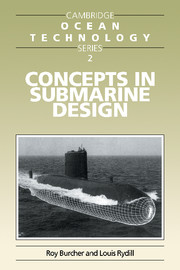Book contents
- Frontmatter
- Contents
- Introduction
- Acknowledgements
- 1 Design in general
- 2 Milestones in submarine history
- 3 Submarine hydrostatics
- 4 The weight/space relationship
- 5 Submarine structures
- 6 Powering of submarines
- 7 Geometric form and arrangements
- 8 Dynamics and control
- 9 Submarine systems
- 10 Considerations of building and costs in design
- 11 Generating a concept design
- Appendix 1 Hydrostatic conditions of flotation
- Appendix 2 Operational practice for keeping in trim
- Appendix 3 Assessing weight and size of variable ballast
- Appendix 4 Submarine pressure hull strength (Prediction of interframe collapse pressures)
- Appendix 5 Estimates of resistance and propulsion
- References and suggested reading
- Index
5 - Submarine structures
Published online by Cambridge University Press: 05 July 2014
- Frontmatter
- Contents
- Introduction
- Acknowledgements
- 1 Design in general
- 2 Milestones in submarine history
- 3 Submarine hydrostatics
- 4 The weight/space relationship
- 5 Submarine structures
- 6 Powering of submarines
- 7 Geometric form and arrangements
- 8 Dynamics and control
- 9 Submarine systems
- 10 Considerations of building and costs in design
- 11 Generating a concept design
- Appendix 1 Hydrostatic conditions of flotation
- Appendix 2 Operational practice for keeping in trim
- Appendix 3 Assessing weight and size of variable ballast
- Appendix 4 Submarine pressure hull strength (Prediction of interframe collapse pressures)
- Appendix 5 Estimates of resistance and propulsion
- References and suggested reading
- Index
Summary
INTRODUCTION
5.1 The main attribute of a submarine is its ability to dive beneath the surface and to go to reasonable operating depths. For a manned submersible there is a requirement for the enclosed volume to be maintained at atmospheric pressure. This need applies not only for the personnel but also for much of the equipment which has been designed to operate in atmospheric conditions. It is desirable to keep the enclosed volume as small as possible so as to limit the weight of structure that is required to withstand the differential pressure between sea pressure at depth and atmosphere. In small unmanned submersibles and ROVs it will usually be possible to minimise the amount of volume that needs to be contained by the pressure carrying structure, but for most large seagoing manned vessels there are inescapable requirements for a considerable amount of volume to be contained within the structural envelope. It may be that the design of a submarine as a whole leads to a decision to include other volumes within the pressure hull although they are not necessarily required to be at atmospheric pressure; for example, some of the main ballast tankage may be included within the pressure hull. It can also be convenient to locate some fuel tanks within the pressure hull so that they can be operated in atmospheric conditions. Variable ballast tanks will usually be located within the pressure hull, even though in some instances they are subject to sea pressure. It is important that where such volumes are inside the pressure hull, steps are taken to enable them to be isolated from sea pressure.
Information
- Type
- Chapter
- Information
- Concepts in Submarine Design , pp. 71 - 99Publisher: Cambridge University PressPrint publication year: 1994
